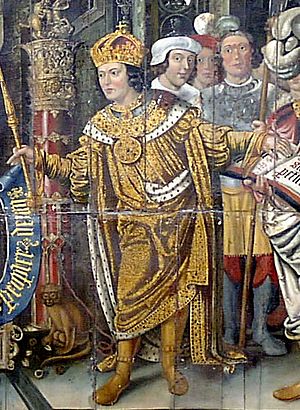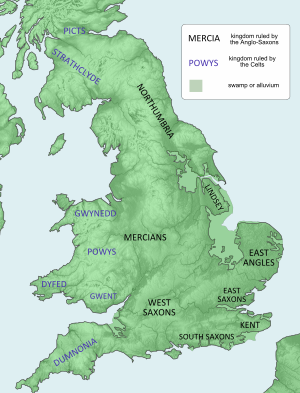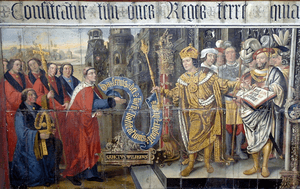Cædwalla of Wessex facts for kids
Quick facts for kids Cædwalla |
|
|---|---|

Imaginary depiction by Lambert Barnard
|
|
| King of Wessex | |
| Reign | 685–688 |
| Predecessor | Centwine |
| Successor | Ine |
| Born | c. 659 |
| Died | 20 April 689 (aged 29–30) , Rome, Italy |
| Spouse | Cynethryth |
| House | Wessex |
| Father | Coenberht |
Cædwalla (born around 659 AD – died 20 April 689 AD) was a powerful king of Wessex, a kingdom in early England. He ruled from about 685 until he gave up his throne in 688. His name comes from the Welsh name Cadwallon.
When he was young, Cædwalla was sent away from Wessex. During this time, he gathered an army. He then attacked the South Saxons, killing their king, Æthelwealh. However, Cædwalla could not keep control of Sussex at first. Local leaders, called ealdormen, drove him out.
In 685 or 686, Cædwalla became King of Wessex. He might have removed other royal families who were trying to rule at this time. After becoming king, Cædwalla returned to Sussex and conquered it again. He also took control of the Isle of Wight, Surrey, and the kingdom of Kent. In 686, he made his brother, Mul, the king of Kent. A year later, Mul was killed in a Kentish rebellion. Cædwalla then returned to Kent, possibly ruling it directly for a while.
Cædwalla was hurt during the conquest of the Isle of Wight. Maybe because of this, he decided to give up his throne in 688. He then traveled to Rome to be baptised. He arrived in Rome in April 689. Pope Sergius I baptised him just before Easter. Cædwalla died ten days later, on 20 April 689. His successor was Ine.
Contents
Wessex in the 680s

In the late 600s, the West Saxons lived in the western part of southern England. Their exact borders are hard to know. To the west was the British kingdom of Dumnonia, in what is now Devon and Cornwall. To the north were the Mercians. Their king, Wulfhere, had been very powerful in southern England.
Wulfhere's brother, Æthelred, became king in 674. He was less active in wars against Wessex. But the West Saxons did not get back the land Wulfhere had taken. To the southeast was the kingdom of the South Saxons. To the east were the East Saxons, who controlled London.
The West Saxons fought in areas like north Somerset, south Gloucestershire, and north Wiltshire. They fought against both British and Mercian groups. We know how far West Saxon power reached from monasteries. Cenwalh, who ruled from 642 to 673, supported Sherborne Abbey in Dorset. Centwine (676–685) supported Glastonbury Abbey in Somerset. This shows these areas were West Saxon territory by then. Exeter in Devon was also under West Saxon control by 680.
First Fight in Sussex
The first time we hear about Cædwalla is in a book about Wilfrid. It says Cædwalla was a noble who had been sent away from Wessex. He was living in the forests of Chiltern and Andred. It was common for a king in the 600s to have been in exile before becoming king. For example, Oswald of Northumbria also spent time in exile.
According to old records, Cædwalla "began to fight for the kingdom" in 685. Even though he was in exile, he gathered enough soldiers. He defeated and killed Æthelwealh, the king of Sussex. However, Cædwalla was soon forced out by Berthun and Andhun. These were Æthelwealh's chief officers, called ealdormen. They then ruled Sussex, possibly as kings themselves.
The Isle of Wight and the Meon valley had been given to Æthelwealh by King Wulfhere. This happened around the 680s. Cædwalla's attack on Æthelwealh might have been a response to Mercian power.
Around this time, the West Saxon church area was divided. A new church center was set up in Winchester. This was very close to the South Saxon border. This change likely happened because the Mercians were moving forward. This forced the West Saxons to expand their power to the west, south, and east. Cædwalla's military wins might be why people started using the term "West Saxon" instead of "Gewisse." From this time, the West Saxons began to rule over other Anglo-Saxon peoples.
Becoming King and His Reign
In 685 or 686, Cædwalla became king of the West Saxons. His predecessor, Centwine, had retired to a monastery. Some records say Cædwalla ruled for two years, ending in 688. Others say three years.
According to Bede, before Cædwalla, Wessex was ruled by several "underkings." These were conquered and removed when Cædwalla became king. This means Cædwalla likely ended their rule. It's possible these underkings were rival family members.
Once he was king, Cædwalla attacked the South Saxons again. This time he killed Berthun, one of the ealdormen. Sussex was then brought under even stricter control. He also conquered the Isle of Wight. This island was still a pagan kingdom. Cædwalla planned to kill all the native people on the island. He wanted to resettle it with his own people. However, Bede says that many natives still remained on the island.
Arwald, the king of the Isle of Wight, had two young brothers. They tried to escape but were found in Stoneham, Hampshire. Cædwalla ordered them to be killed. But a priest convinced him to let them be baptised before they died. Bede also mentions that Cædwalla was wounded during this time. He was recovering when the priest asked to baptise the princes.
In 688, Cædwalla gave land in Farnham for a church. This shows he controlled Surrey. He also invaded Kent in 686. He might have started a monastery at Hoo, near Rochester. He made his brother, Mul, king of Kent. Mul replaced the previous king, Eadric. Later, in a Kentish uprising, Mul was "burned" to death with twelve others. Cædwalla responded by attacking Kent again. He caused great damage and left the area in chaos. He might have ruled Kent directly after this second invasion.
Christianity

Cædwalla was not baptised when he became king. He remained unbaptised throughout his rule. But he was not necessarily a pagan. He might have believed in Christianity but waited to be baptised. He clearly respected the church. Records show he gave land for churches and religious buildings.
When Cædwalla first attacked the South Saxons, Wilfrid was with King Æthelwealh. After Æthelwealh's death, Wilfrid joined Cædwalla. Records say Cædwalla looked to Wilfrid as a spiritual guide. Bede states that Cædwalla promised to give a quarter of the Isle of Wight to the church if he conquered it. Wilfrid received this land when the promise was kept. Bede also says Cædwalla allowed the heirs of Arwald, the king of the Isle of Wight, to be baptised before they were killed.
Two of Cædwalla's charters gave land to Wilfrid. There is also proof that Cædwalla worked with Wilfrid and Eorcenwald, a bishop, to set up churches in Sussex. However, Wilfrid did not seem to influence Cædwalla's military actions.
Wilfrid's connection with Cædwalla might have helped him. The Life of Wilfrid says that the Archbishop of Canterbury, Theodore, wanted Wilfrid to become the next Archbishop. If true, this might show Wilfrid's importance due to his link with Cædwalla's power.
Giving Up the Throne, Baptism, and Death
In 688, Cædwalla gave up his throne. He went on a pilgrimage to Rome. This was possibly because he was dying from wounds he got fighting on the Isle of Wight. Cædwalla had not been baptised. Bede says he wanted to be baptised at the holy place of the Apostles.
He stopped in Francia, near Calais, where he gave money for a church. He also visited the court of Cunincpert, king of the Lombards, in northern Italy. In Rome, Pope Sergius I baptised him. This happened on the Saturday before Easter. Cædwalla took the baptismal name Peter. He died soon after, "still in his white garments." He was buried in St. Peter's church.
Old records agree that Cædwalla died on 20 April. One record says he died seven days after his baptism. But the Saturday before Easter that year was April 10. The words on his tomb called him "King of the Saxons."
Cædwalla's departure in 688 seemed to cause problems in southern England. Ine, Cædwalla's successor, gave up his throne in 726. Records say Ine ruled for thirty-seven years. This means his reign might have started in 689, not 688. This could mean there was a period of unrest between Cædwalla leaving and Ine becoming king.
The kingship also changed in Kent in 688. Oswine, who was likely supported by Mercia, became king. There is also evidence of East Saxon influence in Kent after Cædwalla left.
In 694, Ine demanded 30,000 pence from the people of Kent for Mul's death. This amount was the value of a prince's life in the Saxon system of Weregild. Ine seemed to keep control of Surrey, but he did not get Kent back. No king of Wessex went that far east again until Egbert, over a hundred years later.
See also
 In Spanish: Cædwalla de Wessex para niños
In Spanish: Cædwalla de Wessex para niños

